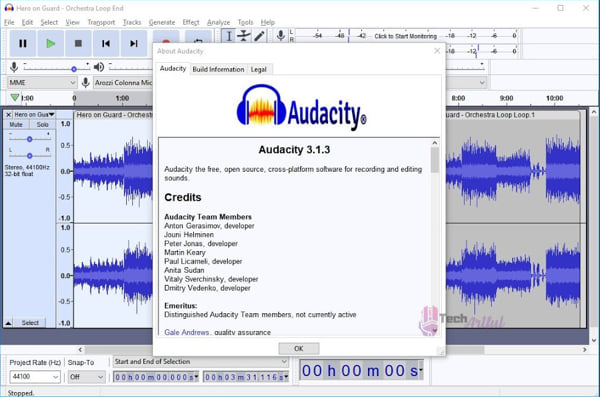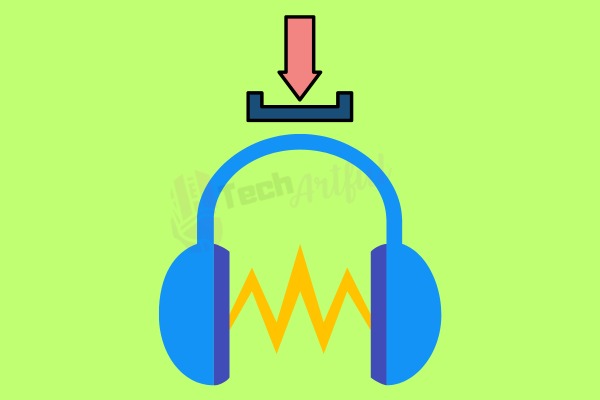The realization that your AirPods will not interact with Audacity while working on an important project under time constraints is too much to bear. You are already aware of Audacity’s features and the excellent qualities it provides as an outstanding tool for virtual studios.
This tool allows for the playing, recording, and editing of various music files in varying formats. In addition, it grants you the capacity to carry out a variety of pretty sophisticated procedures on the music files you own.
When you add the fact that it is free, it is simple to understand how and why a few errors and difficulties may spring up here and there.
When utilizing Audacity, you may notice that the error “Error Opening Sound Device” shows rather frequently.
Why are my AirPods not working with Audacity?
Several variables lead to your AirPods’ incompatibility with Audacity. These elements include an out-of-date operating system version, a faulty Bluetooth connection, etc. However, there are times when faulty software, an operating system update, or even Audacity itself might cause issues, resulting in your AirPods and Audacity not working together. These situations can occur in both the iOS and macOS systems.
We’ll start by discussing various strategies that have been demonstrated to be beneficial. It has been much too long!
How to Fix AirPods Not Working with Audacity
Without question, our favorite feature of Audacity is its ability to reduce ambient noise. It would be best if you first made some noise; only after that can you pick the option to cancel out the noise you made.
However, numerous Audacity users who use AirPods to listen to music or record have claimed that their AirPods no longer work with Audacity. These individuals were listening to music or recording with their AirPods. These individuals utilize AirPods to listen to music or capture videos. Taking up something like this is exceptionally challenging when you have essential duties to fulfill and a rigid timetable to follow.
When it comes to specific persons, they were utilizing Audacity to work on a project that utilized 8D audio. However, headphones are required to engage in the 8D audio experience. Customers may have recently purchased their AirPods. When they attempted to use Audacity with the only pair of AirPods they had, they discovered that the program was incompatible with them.
We have compiled a viable list of potential remedies for you to consider implementing one at a time to fix your problem once and for all. You should complete all parts and should continue reading until the issue is resolved.
To fix the issue of your AirPods not being compatible with Audacity, you will need to use one of the fixes indicated below, all of which have been tested:
Upgrade Audacity
Check to see if the version of Audacity currently installed on your computer is the most recently accessible. Audacity versions 1.2.x and 1.3.x are presently considered outdated and will no longer get maintenance updates.
You can do so by selecting the “Upgrade” option. Go to your computer’s Audacity menu and select the About Audacity option to discover more about the version of Audacity you’re currently running.
Note: Before proceeding with any of the following processes, ensure that the Audacity application on your computer has been restarted.
Ensure Good Bluetooth Connection
For the sake of this discussion, we’ll assume you’re utilizing the microphone built into your laptop as an output device and the AirPods as an input device, or vice versa, depending on your preferences. What a deplorable condition of affairs!
This will guarantee that your AirPods are always operational. The following is the most straightforward approach for restoring your AirPods to factory settings:
- After placing your AirPods inside the case, replace the lid and then the top.
- After between thirty and forty seconds, remove the cover.
- Navigate to Settings > Bluetooth on your iPhone to configure the Bluetooth settings.
- You may select “Forget This Device” by tapping the “I” button.
- You may couple your smartphone with the charging case by pressing and holding the pairing button on the back of the case until the light flashes amber, red, and orange three times, then white. The light on the casing will then flash white.
- Reestablish the previously broken connection between the AirPods and the Mac. Launch Audacity and thoroughly analyze the program to determine whether the problem has been rectified. If it does, you should go to the next step.
Before proceeding with this procedure, ensure that your AirPods still have at least some battery life.
Choose the Correct Output
On rare occasions, Audacity cannot connect AirPods at any stage throughout the procedure, or a similar error happened while the Edit was performed. In this case, making the proper choice concerning the Output is essential to complete the issue-solving process. The following are the steps you must follow to connect your AirPods to Audacity:
- Launch Audacity first, then browse the program’s main menu to study the available options.
- Navigate to the “Transport” menu, then choose “Rescan Audio Devices.”
- Choose your AirPods from the dropdown menu after selecting the Build-in Output option on your smartphone.
This update benefited many consumers who were experiencing issues with their AirPods not working correctly with Audacity. Those users may now use their AirPods without a problem. We hope this will also assist you in finding a solution.
Reinstall Audacity
As this is a possibility, the problem might begin within Audacity itself. If this is the case, delete Audacity from your computer and reinstall it after some time has elapsed.
You may remove Audacity from your Mac by following the steps outlined in this article:
- Search for Audacity in the Finder to find out where it is. If you cannot find it in that place, you may access it by selecting Applications from the sidebar of any Finder window.
- You can get rid of Audacity by dragging it to the garbage pail. You may also choose Audacity, browse the File menu, and select the Move to Trash option.
- Select Empty Trash after choosing Finder from the dropdown menu that appears.
Check to see whether the problem with Audacity being unable to hear over Bluetooth is still present and if so, go to the next step. If the issue has been resolved, return to the previous step.
Return to the Old OS
After upgrading to the most current version of macOS, Monterey, several consumers have noticed that Audacity no longer works properly with their AirPods. These reports may be viewed on Apple’s discussion forums. My voice-over artist pals have also expressed their concerns to me and confirmed that their problems began with the most recent software upgrade.
If you realize that you are familiar with the previous circumstance, you should not be afraid to return to the operating system you previously used. Check to see if this fixes the problem of Audacity not being able to play via your AirPods.
Uninstall Problematic Applications
If you cannot identify any problematic programs that may be the source of the problem, you may wish to try this strategy.
It is recommended that you delete all of your programs one at a time and check after each uninstallation to see whether the problem with your AirPods not being compatible with Audacity has been resolved. This method of determining the problem could be more efficient and convenient. But if you have some extra time, give it a chance.
Restart your computer
Sometimes, the ideas that are easier to adopt wind up having a more significant impact. Please verify that this is the case by investigating it in light of the circumstances that we demand. Open System Preferences from the top left corner of the screen.
Pick Sound from the menu, and then select Output. Examine the Output to see if it has the correct information. Then restart the computer. We’re crossing our fingers that this will resolve the issue where the AirPods cannot sync with Audacity.
The Problem Can Be Within Audacity
If you’re using Audacity to record Sound, ensure sure Software Playthrough is switched off until the recording is done. This is likely the component that contributed to the error. Please continue reading to learn how to disable it in your browser. Launch Audacity, go to the program’s menu, and select Edit from the upper left of the screen.
Select the Recording tab from the menu after clicking the Preferences button. You should notice a checkbox at the very top, just underneath the phrase “Playthrough,” which you must deactivate before hitting the OK button. This is the only choice you have at this time.
Furthermore, it is strongly advised that you double-check the audio equipment settings to ensure that they are correctly set up. Continue with the steps given below.
- Launch Audacity, then choose Edit from the screen’s dropdown menu in the upper-right corner.
- Select Devices from the menu after choosing Preferences.
- Windows WASAPI must be included in the documentation’s Host section. If it isn’t already, you should alter it such that it utilizes WASAPI.
- Finally, make sure to click the “OK” button after making your selections.
Try other Audio Editing Applications
If none of those, as mentioned earlier, methods work for you; you may try a different piece of audio manipulation software, such as Ocenaudio, Ashampoo Music Studio, Audiotool, or Acoustica.
You should consider utilizing this one if you have considerable time to experiment with a new program. If you do, please use it.
Why Did You Get the Audacity Error
When you receive this notice, Audacity will prompt you to investigate the playback or recording device options and the sample rate of the projects you presently have open in the software. If the alert shows that the problem is with the recording device, the problem is likely with your operating system, your sound device’s recording settings, or Audacity itself.
If the warning does not indicate the problem with the recording equipment, the problem is likely with Audacity.
You should investigate the playback settings in case the playing device is the source of the problem. If you see one of these warnings, there might be an issue with the sound device or the driver. You may be instructing the gadget to do a function that is outside the boundaries of what it is capable of.
This includes recording on more channels than your device permits or using the device to overdub (playing one track and recording another on top of it) when it can only perform one thing at a time. This also involves recording on more channels than your device allows you to. Other options include recording on a more significant number of channels than your device allows (playback or recording).
The most common cause of Windows recording device failures is that some of your sound device inputs are not responding to Audacity. This is the most common issue. To put it another way, it shows that Audacity will not be able to begin recording in any capacity.
It is sound knowledge that combining the excellent Audacity app with one’s AirPods is a great combo. This is especially true when it comes to audio editing. On t possible that we’ll run into problems while trying to record audio using AirPods and Audacity. If this describes your situation, all you need to do is recollect the principles we discussed in a previous meeting and put them into action correctly.
FAQ
How do I fix the error in opening the sound device in Audacity?
To begin, ensure that Audacity’s list of audio devices is up to date by selecting the default option in the Device Toolbar, then heading to the Transport menu and selecting the Rescan Audio Devices option. If the problem persists, you should double-check the Audacity setup settings. It’s conceivable that one program has complete control over the audio device, preventing any other applications from using it. If that program had full control, this would be the case.
Why isn’t Audacity picking up my audio?
As a result, Audacity will not pick up the microphone if you have the privacy settings on. Follow these steps to double-check your selections for the various privacy options; Open the computer’s settings menu, and then scroll all the way down until you find the privacy option. You must go to the microphone settings and enable the option that says “allow applications to access the mic.”



